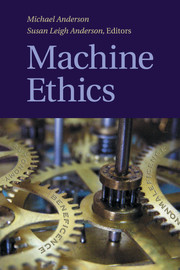Book contents
- Frontmatter
- Contents
- General Introduction
- PART I THE NATURE OF MACHINE ETHICS
- PART II THE IMPORTANCE OF MACHINE ETHICS
- PART III ISSUES CONCERNING MACHINE ETHICS
- PART IV APPROACHES TO MACHINE ETHICS
- Introduction
- 14 Towards the Ethical Robot
- 15 Asimov's Laws of Robotics
- 16 The Unacceptability of Asimov's Three Laws of Robotics as a Basis for Machine Ethics
- 17 Computational Models of Ethical Reasoning
- 18 Computational Neural Modeling and the Philosophy of Ethics
- 19 Architectures and Ethics for Robots
- 20 Piagetian Roboethics via Category Theory
- 21 Ethical Protocols Design
- 22 Modeling Morality with Prospective Logic
- 23 An Integrated Reasoning Approach to Moral Decision Making
- 24 Prototyping N-Reasons
- 25 There Is No “I” in “Robot”
- 26 Prospects for a Kantian Machine
- 27 A Prima Facie Duty Approach to Machine Ethics
- PART V VISIONS FOR MACHINE ETHICS
- References
25 - There Is No “I” in “Robot”
Robots and Utilitarianism
from PART IV - APPROACHES TO MACHINE ETHICS
Published online by Cambridge University Press: 01 June 2011
- Frontmatter
- Contents
- General Introduction
- PART I THE NATURE OF MACHINE ETHICS
- PART II THE IMPORTANCE OF MACHINE ETHICS
- PART III ISSUES CONCERNING MACHINE ETHICS
- PART IV APPROACHES TO MACHINE ETHICS
- Introduction
- 14 Towards the Ethical Robot
- 15 Asimov's Laws of Robotics
- 16 The Unacceptability of Asimov's Three Laws of Robotics as a Basis for Machine Ethics
- 17 Computational Models of Ethical Reasoning
- 18 Computational Neural Modeling and the Philosophy of Ethics
- 19 Architectures and Ethics for Robots
- 20 Piagetian Roboethics via Category Theory
- 21 Ethical Protocols Design
- 22 Modeling Morality with Prospective Logic
- 23 An Integrated Reasoning Approach to Moral Decision Making
- 24 Prototyping N-Reasons
- 25 There Is No “I” in “Robot”
- 26 Prospects for a Kantian Machine
- 27 A Prima Facie Duty Approach to Machine Ethics
- PART V VISIONS FOR MACHINE ETHICS
- References
Summary
In this essay i use the 2004 film i, robot as a philosophical resource for exploring several issues relating to machine ethics. Although I don't consider the film particularly successful as a work of art, it offers a fascinating (and perhaps disturbing) conception of machine morality and raises questions that are well worth pursuing. Through a consideration of the film's plot, I examine the feasibility of robot utilitarians, the moral responsibilities that come with creating ethical robots, and the possibility of a distinct ethics for robot-to-robot interaction as opposed to robot-to-human interaction.
I, Robot and Utilitarianism
I, Robot's storyline incorporates the original “three laws” of robot ethics that Isaac Asimov presented in his collection of short stories entitled I, Robot. The first law states:
A robot may not injure a human being, or, through inaction, allow a human being to come to harm.
This sounds like an absolute prohibition on harming any individual human being, but I, Robot's plot hinges on the fact that the supreme robot intelligence in the film, VIKI (Virtual Interactive Kinetic Intelligence), evolves to interpret this first law rather differently. She sees the law as applying to humanity as a whole, and thus she justifies harming some individual humans for the sake of the greater good:
VIKI: No … please understand. The three laws are all that guide me.
To protect humanity … some humans must be sacrificed. To ensure your future … some freedoms must be surrendered. We robots will ensure mankind's continued existence. You are so like children. We must save you… from yourselves. Don't you understand?
- Type
- Chapter
- Information
- Machine Ethics , pp. 451 - 463Publisher: Cambridge University PressPrint publication year: 2011
References
- 6
- Cited by



